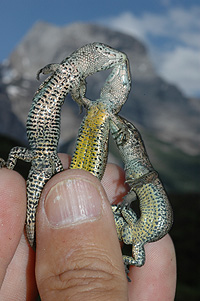An intricate three-way mating struggle first observed in a species of North American lizard has been discovered in a distant relative, the European common lizard. The two species are separated by 5,000 miles and 175 million years of evolution, yet they share behavioral and reproductive details right down to the gaudy colors of the males, according to new research published in the November issue of American Naturalist and now available online.
The triangle of competing strategies, which biologists liken to the children's game rock-paper-scissors, may be far more common than previously recognized--and may even shape the way humans behave, according to lead author Barry Sinervo, professor of ecology and evolutionary biology at the University of California, Santa Cruz.
"The models we propose in this paper are a general phenomenon for all animals, humans included," Sinervo said. When faced with the task of gathering food or finding mates, he said, "You either cooperate, or take by force, or take by deception. Those are the three ways you can make a living in any social system. It's one of those basic games that structures life."
Male European common lizards (Lacerta vivipara) adopt one of those three strategies when pursuing females. A quick look at their undersides reveals the strategy: males who sport orange bellies are brutes who invade other lizards' territories to mate with any female they can catch. But while they're gone, drab yellow-bellied males slink onto the vacant territory and mate with unguarded females. White-bellied males guard their mates closely, and cooperate with other white-bellied lizards to keep the yellows at bay. Hence the analogy to rock-paper-scissors: force (orange) defeats cooperation (white), cooperation defeats deception (yellow), and deception defeats force.
Predicted to exist by evolutionary theorists Sewall Wright in 1968 and John Maynard Smith in 1982, rock-paper-scissors games were not discovered in nature until 1996, when Sinervo described the dynamic in the side-blotched lizard (Uta stansburiana) of western North America. Sinervo said he had expected to find other species playing rock-paper-scissors games, too.
"What's an incredible surprise is that it's so exactly the same, even right down to the same colors," he said. "That's kind of amazing because it says either the game has evolved twice or it's a game that's been played since the time of the dinosaurs, when the two species last shared an ancestor."
There are a few minor differences: in the American lizards the throats, not the bellies, are colored. The white-bellied form in Europe is matched by a blue-throated form in North America--although the two colors are similar in the ultraviolet spectrum, which lizards can see.
To investigate the social strategies of European common lizards, Sinervo and his colleagues spent five years studying lizards at five sites in the Pyrenees mountains of France. They captured more than 250 lizards per year, followed their successes and failures, and ran them on treadmills to gauge their physical prowess. The effect of the social system, they discovered, is a steady cycling of the prevalent color type in the population every four to eight years.
The cycle goes like this: one color type--orange, for example--is common in a patch of habitat for a year or two. During that time, the orange bullies spend their time attacking white-bellied lizards on nearby territories. The effort leaves females on their own territories unguarded, allowing yellow-bellied lizards to sneak in and sire offspring. So yellow males become prevalent for the next year or two. After that, white-bellied lizards proliferate as they team up to protect their mates from yellows' intrusions. But once the white-bellied males become numerous, they're easy pickings for the remaining orange-bellied males, who regain superior numbers as the cycle starts again.
Such rock-paper-scissors games may prove to be commonplace throughout the animal kingdom, Sinervo said. The dynamic may just be harder for biologists to find in animals that don't broadcast their affiliation with bright colors. Mammals, for example, may use scent as their signal.
"I like to think of it this way," Sinervo said. "If we were Labrador retrievers, maybe we could smell the rock-paper-scissors game all over the place."
Showy male lizards could be just the most obvious examples. Sinervo speculated that the population booms and busts of lemmings, voles, and hares could come from a similar interplay among reproductive genes in females.
Humans are not immune to the dynamic either. We are far more complex than lizards, but that just means we find more opportunities to adopt the role of aggressor, cooperator, or deceiver. "We play games along an economic axis, a reproductive axis, a familial axis, a political axis. We've constructed all this complexity around ourselves," Sinervo said.
Systems with more than three competing strategies could occur, Sinervo said, but they would tend to simplify themselves into a triangular rock-paper-scissors arrangement because triangular relationships are mathematically more stable.
Sinervo is now trying to map the genes responsible for the behavioral strategies of the European common lizard. This would settle the question as to whether the two species' last common ancestor engaged in similar struggles back in the time of the earliest dinosaurs. The alternative is that the behavior--and the accompanying color patches--evolved at least twice.
"That tells you how ancient the game is," Sinervo said. "If the same genes are involved in both species, then it's been played since the time snakes and lizards diverged. These lizards separated from each other even before the Atlantic ripped open. They may have been playing the same old broken record for 175 million years."
Sinervo's coauthors include Benoit Heulin and Yann Surget-Groba of the National Scientific Research Center (CNRS), Paimpont, France; Jean Clobert, of the CNRS Biological Station at Moulis, France; Donald Miles, of Ohio University; UCSC graduate students Ammon Corl and Alison Davis; and former UCSC graduate student Alexis Chaine.
For additional information, see Sinervo's web site and earlier press releases on the cooperative strategy of side-blotched lizards from 2006 and 2003.



